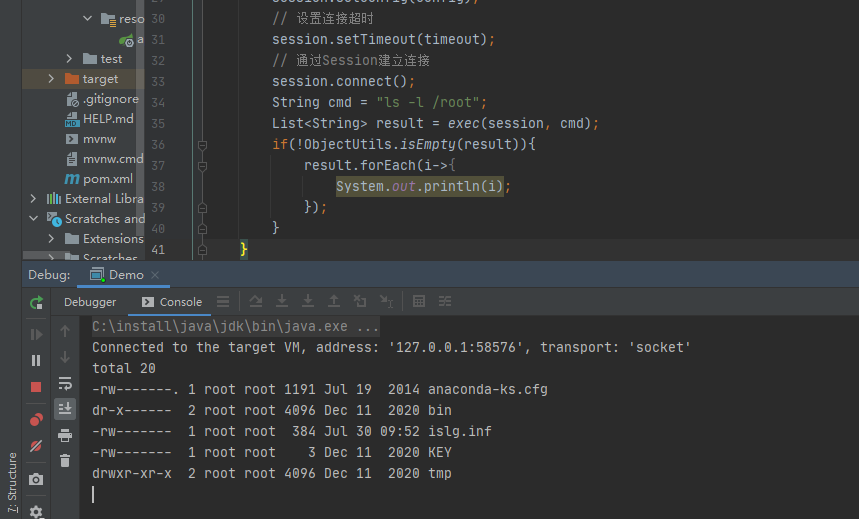一、Java-SSH连接执行远程服务命令
一、前言
- 刚好,项目需要调用远程服务器的命令,所以研究一波
- 目前,Java执行远程命令的第三方包常用的有:jsch、ganymed-ssh2、
- 本文的例子是 jsch
二、导入依赖
- 导入jsch的依赖,最近的更新时间是2018年:
0.1.55 版本
- 可能是因为Java 执行第三方的需求比较少吧,所以市面上可使用的Jar很少
1
2
3
4
5
| <dependency>
<groupId>com.jcraft</groupId>
<artifactId>jsch</artifactId>
<version>0.1.55</version>
</dependency>
|
三、快速开始
1、shell登录
- 可直接通过Java控制台与远程服务器shell命令交互
- 简单代码如下:
1
2
3
4
5
6
7
8
9
10
11
12
13
14
15
16
17
18
19
20
21
22
23
24
25
26
27
28
29
30
31
32
33
34
35
| public class Demo {
public static void main(String[] args) throws JSchException {
//远程服务用户名
String username = "root";
// 远程服务ip
String host = "192.168.2.25";
// 远程服务密码
String password = "root";
// 连接超时 10秒
int timeout = 10000;
int port = 22;
JSch jSch = new JSch();
Session session = jSch.getSession(username, host, port);
// 设置密码
session.setPassword(password);
Properties config = new Properties();
// 设置第一次登录的时候提示,可选值:(ask | yes | no)
config.put("StrictHostKeyChecking", "no");
// 为Session对象设置properties
session.setConfig(config);
// 设置连接超时
session.setTimeout(timeout);
// 通过Session建立连接
session.connect();
// 打开shell通道
Channel shell = session.openChannel("shell");
// 控制台接收输入
shell.setInputStream(System.in);
// 控制台接收输出
shell.setOutputStream(System.out);
// 超时时间,0 表示无限制
shell.connect(3*1000);
}
}
|
- 执行,不出问题即可看到控制台已连接到服务端了,执行linux命令了

- 如上是控制台交互的,如果要直接执行命令,java接收呢?如下
2、执行远程Linux命令
- 和上面一样,也是创建一个session,然后通过session,打开一个命令通道即可。
- 例子如下:
1
2
3
4
5
6
7
8
9
10
11
12
13
14
15
16
17
18
19
20
21
22
23
24
25
26
27
28
29
30
31
32
33
34
35
36
37
38
39
40
41
42
43
44
45
46
47
48
49
50
51
52
53
54
55
56
57
58
59
60
61
62
63
64
65
66
67
68
69
70
71
| public class Demo {
public static void main(String[] args) throws JSchException {
String username = "root";
String host = "192.168.2.25";
String password = "root";
int timeout = 10000;
int port = 22;
JSch jSch = new JSch();
Session session = jSch.getSession(username, host, port);
session.setPassword(password);
Properties config = new Properties();
config.put("StrictHostKeyChecking", "no");
session.setConfig(config);
session.setTimeout(timeout);
session.connect();
// 打印root目录下的信息
String cmd = "ls -l /root";
List<String> result = exec(session, cmd);
if(!ObjectUtils.isEmpty(result)){
result.forEach(i->{
System.out.println(i);
});
}
}
/**
* 执行命令
* @param command 命令
* @return list
* @throws JSchException err
*/
public static List<String> exec(Session session,String command) throws JSchException {
List<String> resultLines = new ArrayList<>();
ChannelExec channel = null;
try{
channel = (ChannelExec) session.openChannel("exec");
channel.setCommand(command);
channel.setInputStream(null);
channel.setErrStream(System.err);
channel.connect(10000);
InputStream input = channel.getInputStream();
try {
BufferedReader inputReader = new BufferedReader(new InputStreamReader(input));
String inputLine = null;
while((inputLine = inputReader.readLine()) != null) {
resultLines.add(inputLine);
}
} finally {
if (input != null) {
try {
input.close();
} catch (Exception e) {
// todo...
e.printStackTrace();
}
}
}
} catch (IOException e) {
} finally {
if (channel != null) {
try {
channel.disconnect();
} catch (Exception e) {
e.printStackTrace();
}
}
}
return resultLines;
}
}
|
- session的获取和第一个一样,也就是说,后期可以做封装方便调用
- 使用:
session.openChannel("exec") 打开一个命令通道,然后接收命令返回即可
- 结果如下图:

3、文件上传下载
- 除了调用命令,文件的上传下载也是常用的功能
- jsch 里面的ChannelSftp实现了SFTP核心类,它包含了所有SFTP的方法,如:
put(): 文件上传get(): 文件下载cd(): 进入指定目录ls(): 得到指定目录下的文件列表rename(): 重命名指定文件或目录rm(): 删除指定文件mkdir(): 创建目录rmdir(): 删除目录
等等(这里省略了方法的参数,put和get都有多个重载方法,具体请看源代码:com.jcraft.jsch.ChannelSftp
Jsch支持三种文件传输模式:
1
2
3
4
5
6
7
8
|
public static final int OVERWRITE=0;
public static final int RESUME=1;
public static final int APPEND=2;
|
①、文件上传
- 使用的是
put() 方法,所有重载方法,最终都会调用的方法如下:
1
2
3
| public void put(String src, String dst,SftpProgressMonitor monitor, int mode) throws SftpException{
// ...
}
|
- 参数解释:
- 第一个参数:src,将本地文件名为src的文件上传到目标服务器
- 第二个参数:dst,目标文件名为dst,若dst为目录,则目标文件名将与src文件名相同
- 第三个参数:monitor,monitor对象来监控文件传输的进度。
- 第四个参数:mode,文件的传输方式,采用默认的传输模式:
OVERWRITE
还是之前的Demo,如下:
1
2
3
4
5
6
7
8
9
10
11
12
13
14
15
16
17
18
19
20
21
22
23
24
25
26
27
28
29
30
31
32
33
34
35
36
37
38
39
40
41
42
43
44
45
46
47
48
49
50
| public class Demo {
public static void main(String[] args) throws JSchException {
String username = "root";
String host = "192.168.2.25";
String password = "root";
int timeout = 10000;
int port = 22;
JSch jSch = new JSch();
Session session = jSch.getSession(username, host, port);
session.setPassword(password);
Properties config = new Properties();
config.put("StrictHostKeyChecking", "no");
session.setConfig(config);
session.setTimeout(timeout);
session.connect();
String src="C:\\MyHome\\md\\jvm.txt";
String target="/root/jvm.txt";
uploadFile(session,src,target);
}
public static boolean uploadFile(Session session,String src,String target){
try{
ChannelSftp channelSftp = (ChannelSftp) session.openChannel("sftp");
channelSftp.connect();
File file = new File(src);
channelSftp.put(new FileInputStream(file), target,null, ChannelSftp.OVERWRITE);
System.out.println("上传成功");
channelSftp.exit();
}catch (Exception e){
e.printStackTrace();
return false;
}
return true;
}
}
|
- 上面的例子是没有监控文件的上传进度,那如果要使用怎么办,如下
- 实现
SftpProgressMonitor 接口,重写其方法即可,代码里面有注释
1
2
3
4
5
6
7
8
9
10
11
12
13
14
15
16
17
18
19
20
21
22
23
24
25
26
27
28
29
30
31
32
33
34
35
36
37
38
39
| /**
* 自定义sftp上传监控
*/
public class MySftpProgressMonitor implements SftpProgressMonitor {
private long transfered;
/**
* 当文件开始传输时,调用init方法。
* @param op
* @param src
* @param dest
* @param max
*/
@Override
public void init(int op, String src, String dest, long max) {
System.out.println("这里可以做一些初始化操作");
}
/**
* 当每次传输了一个数据块后,调用count方法,count方法的参数为这一次传输的数据块大小
* @param count
* @return
*/
@Override
public boolean count(long count) {
transfered+=count;
System.out.println("当前已传输:"+transfered);
return true;
}
/**
* 当传输结束时,调用end方法
*/
@Override
public void end() {
System.out.println("传输完成");
}
}
|

②、文件下载
1
2
3
4
5
6
7
8
9
10
11
12
13
14
15
16
17
18
19
| public static boolean download(Session session,String src,String target){
try{
// 打开channelSftp
ChannelSftp channelSftp = (ChannelSftp) session.openChannel("sftp");
// 远程连接
channelSftp.connect();
// 创建一个文件名称问uploadFile的文件
File file = new File(src);
channelSftp.get(src,target,new MySftpProgressMonitor(),ChannelSftp.OVERWRITE);
System.out.println("下载成功");
// 切断远程连接
channelSftp.exit();
}catch (Exception e){
e.printStackTrace();
return false;
}
return true;
}
|
1
2
3
4
5
6
7
8
9
10
11
12
13
14
15
16
17
18
19
20
21
22
23
24
25
| public static void main(String[] args) throws JSchException {
String username = "root";
String host = "192.168.2.25";
String password = "root";
int timeout = 10000;
int port = 22;
JSch jSch = new JSch();
Session session = jSch.getSession(username, host, port);
// 设置密码
session.setPassword(password);
Properties config = new Properties();
config.put("StrictHostKeyChecking", "no");
// 为Session对象设置properties
session.setConfig(config);
// 设置连接超时
session.setTimeout(timeout);
// 通过Session建立连接
session.connect();
// 要下载的远程服务器文件
String src="/root/test.pdf";
// 保存到哪里
String target="C:\\MyHome\\test2.pdf";
download(session,src,target);
}
|
- 如果是网页下载的话,直接传一个
response.getOutputStream()过去就可以了,如下:
1
2
3
4
5
6
7
8
9
10
11
12
13
14
15
16
17
18
19
| public static boolean download(Session session,String src,OutputStream out){
try{
// 打开channelSftp
ChannelSftp channelSftp = (ChannelSftp) session.openChannel("sftp");
// 远程连接
channelSftp.connect();
// 创建一个文件名称问uploadFile的文件
File file = new File(src);
channelSftp.get(src,out,new MySftpProgressMonitor(),ChannelSftp.OVERWRITE,0);
System.out.println("下载成功");
// 切断远程连接
channelSftp.exit();
}catch (Exception e){
e.printStackTrace();
return false;
}
return true;
}
|
4、跳板机
- 可以通过Session的
setPortForwardingL() 方法进行转发,但是我这边运行失败
- 不知道是不是需要在linux执行才能成功,我是windows IDEA运行的,以后再研究一下。代码如下:
1
2
3
4
5
6
7
8
9
10
11
12
13
14
15
16
17
18
19
20
21
22
23
24
25
26
27
28
29
30
31
32
33
34
35
36
37
| public static void main(String[] args) throws Throwable {
String username = "root";
String host = "192.168.2.25";
String password = "root";
int timeout = 10000;
int port = 22;
JSch jSch = new JSch();
Session session = jSch.getSession(username, host, port);
session.setPassword(password);
Properties config = new Properties();
config.put("StrictHostKeyChecking", "no");
session.setConfig(config);
session.setTimeout(timeout);
session.connect();
String targetHost = "192.168.2.189";
int targetPort = 22;
int forwardPort=18008;
int assetPort = session.setPortForwardingL("127.0.0.1", forwardPort, targetHost, targetPort);
Session targetSession = jSch.getSession(username, host, assetPort);
targetSession.setPassword(password);
Properties targetConfig = new Properties();
targetConfig.put("StrictHostKeyChecking", "no");
targetSession.setConfig(targetConfig);
targetSession.connect();
System.out.println("success");
Channel shell = targetSession.openChannel("shell");
shell.setInputStream(System.in);
shell.setOutputStream(System.out);
shell.connect(3*1000);
}
|
您的打赏,是我创作的动力!不给钱?那我只能靠想象力充饥了。

微信支付

支付宝




